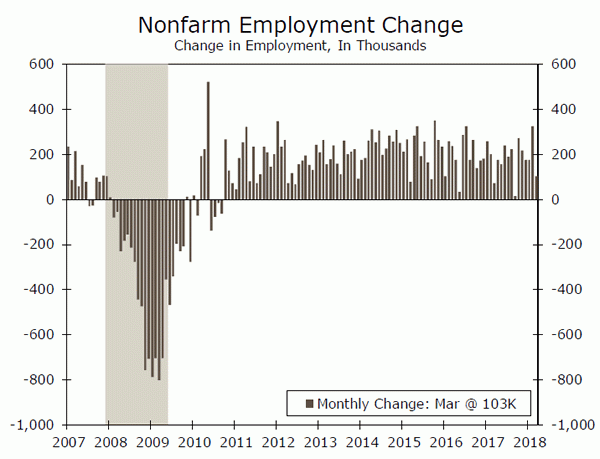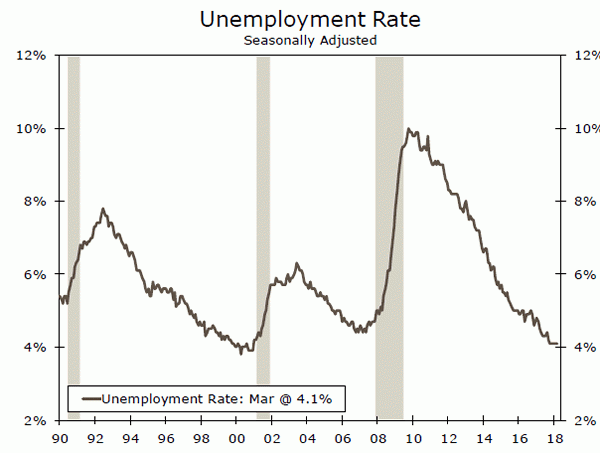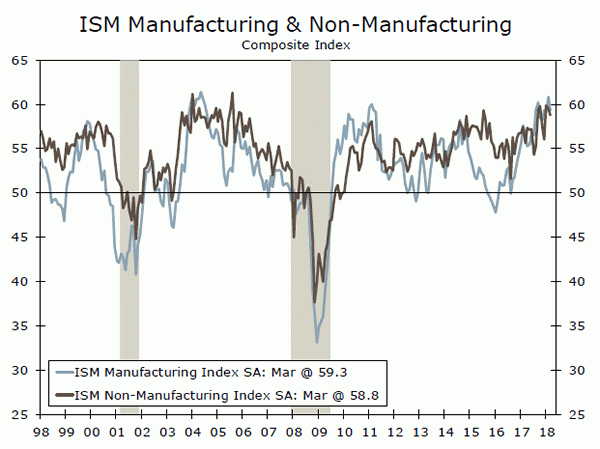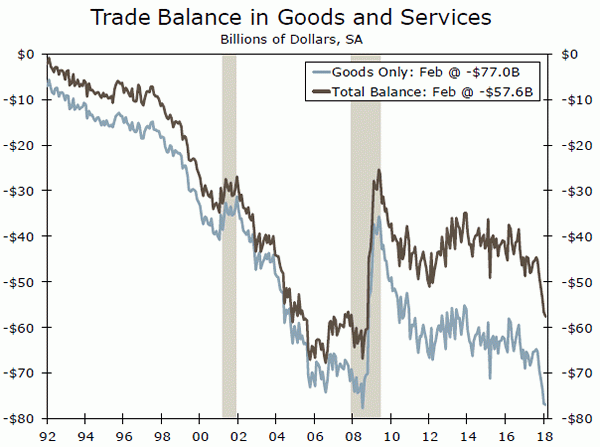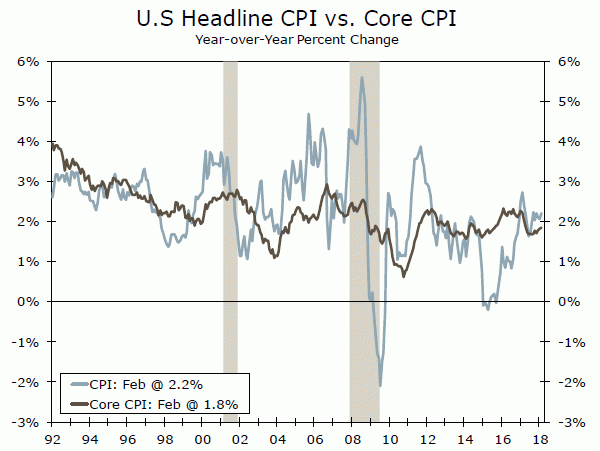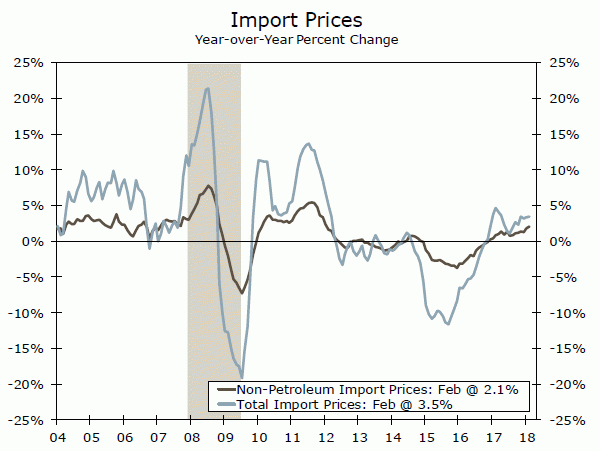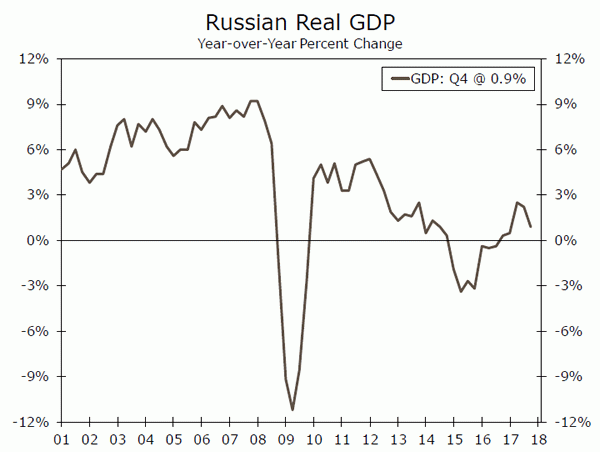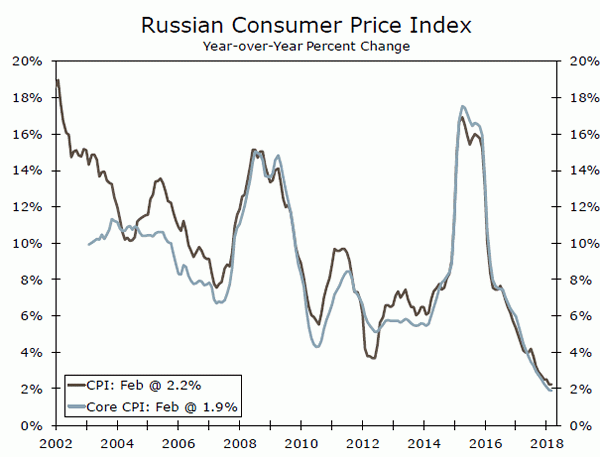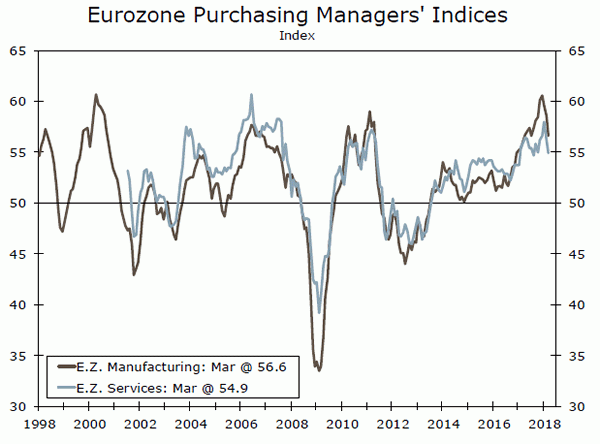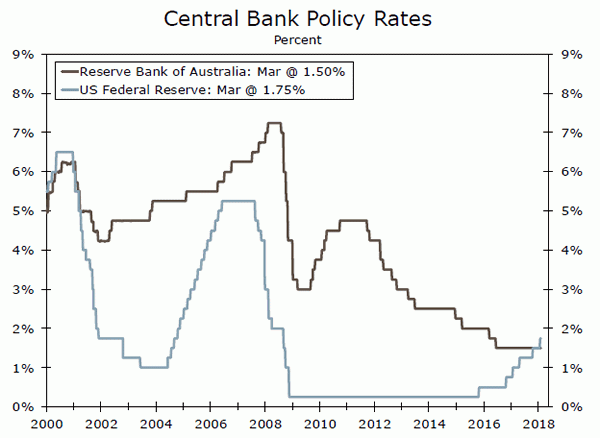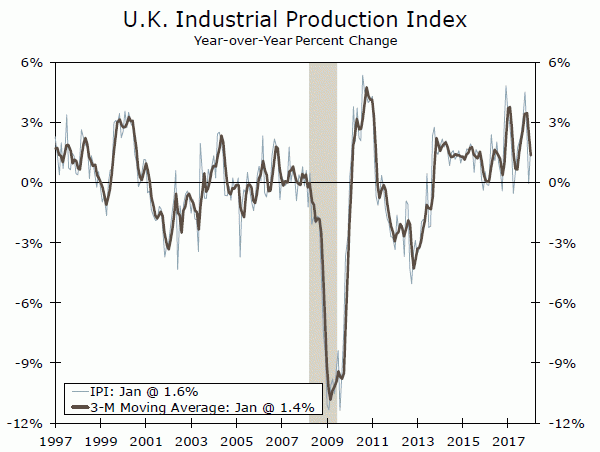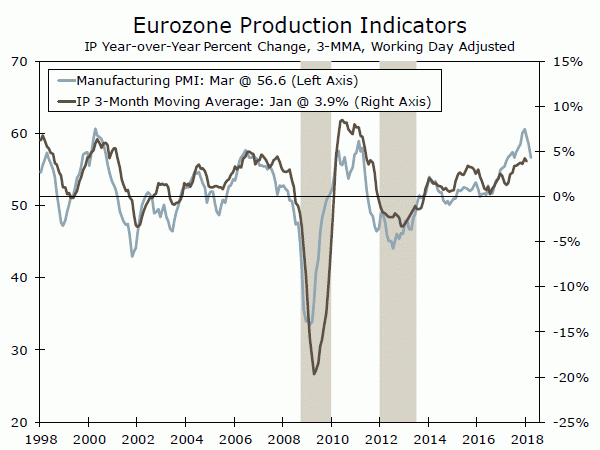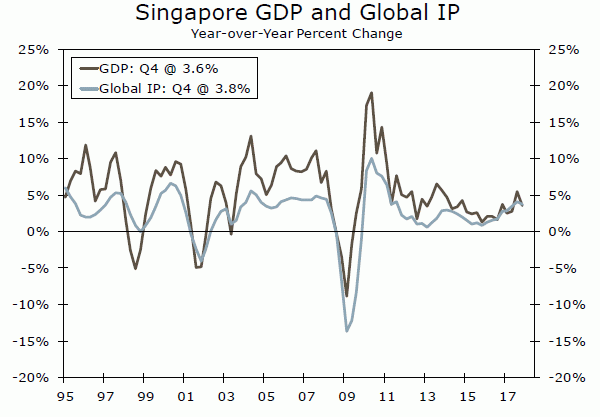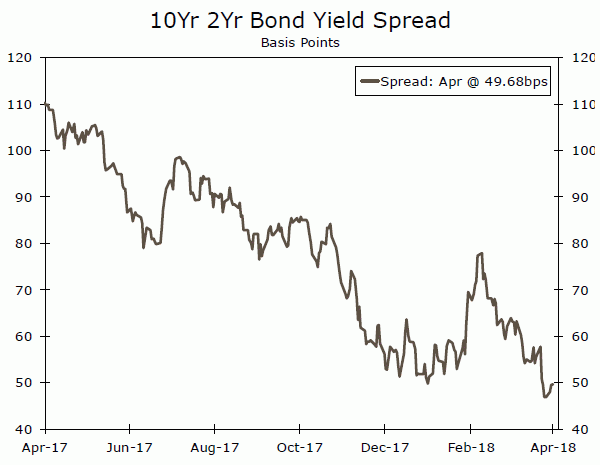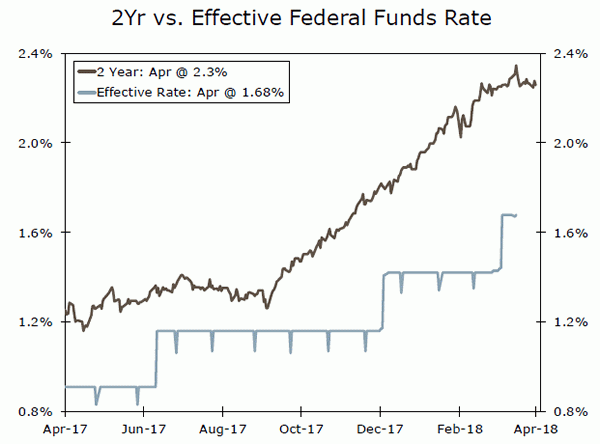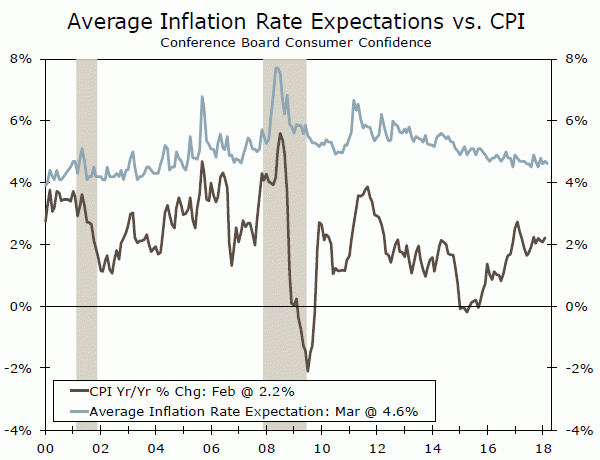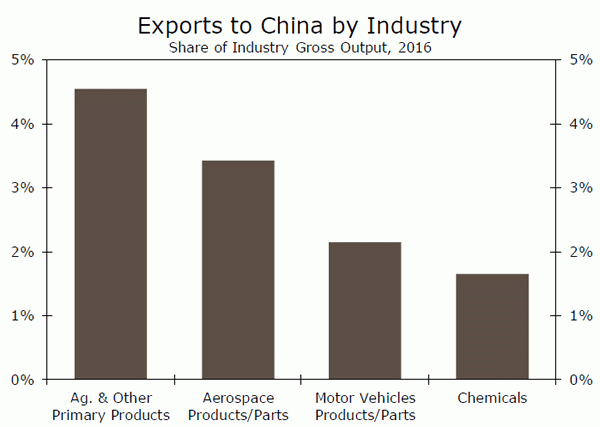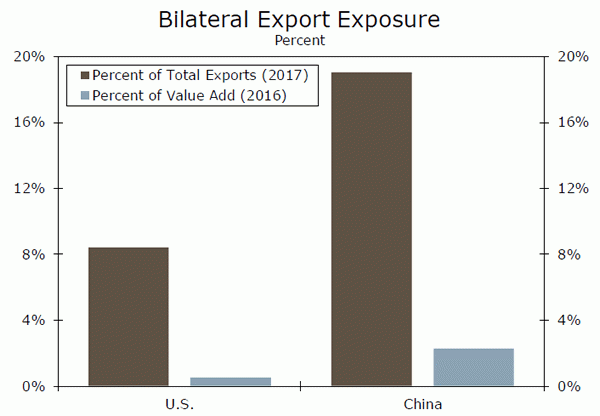U.S. Review
Solid Momentum Beneath the Headlines
- Swings in winter weather appear to be behind most of the below-consensus 103,000-job rise in March nonfarm payrolls. Job growth averaged 202,000 per month during the first quarter.
- Both the ISM manufacturing and non-manufacturing indices eased in March but both remain at levels consistent with real GDP growth in the 3 percent range or better.
- Motor vehicle sales came in slightly stronger than expected, suggesting that March may see a bit of a bounce back in consumer spending.
March Data Ease Back a Notch
Early reports for March suggest we will see some pullback from the exceptionally strong data reported earlier this year. The more moderate numbers do not likely reflect a change in the economy’s underlying momentum, however. The economy appears to be growing quite solidly on an overall basis and any sting from March’s below-consensus 103,000-job gain is easily offset by the 202,000 jobs added on average during the first quarter. The unemployment rate was unchanged at 4.1 percent, although the prior month’s number was rounded down to 4.1 percent and the March figure was rounded up.
Beneath the headlines, the March employment report marks another solid month of gains. The shortfall in employment growth was mostly due to swings in construction and retail payrolls. Construction payrolls added 65,000 jobs in February, which was driven by unseasonably mild weather, particularly in California. March saw the return of winter weather in the Northeast and a subsequent 15,000-job pullback in construction jobs. For the quarter as a whole, builders added 78,000 jobs, which seems consistent with the improvement we are seeing in single-family home construction.
The other big swing was in retail trade, which reportedly added 47,000 jobs in February but then cut 4,000 positions in March. Even with all the turmoil in retailing these swings likely exaggerate the swing in retail employment, which has huge seasonal moves around Christmas and Easter.
Aside from these swings, the employment data look fairly solid. Two of the indicators we like to focus on are the diffusion index, which measures the share of industries adding jobs over the past month, and total hours worked, which combines the changes in employment with changes in weekly hours. Both remain exceptionally strong. The diffusion index for private sector employers fell from an astounding 71.1 in February to a still outstanding 62.6. The average for the past two months is well above the average for the past few years and is consistent with what we are seeing in the ISM surveys, which are also diffusion indices.
Both ISM indices edged back in March. The ISM manufacturing index fell 1.5 points to 59.3. Any reading above 50 means that more manufacturers are seeing improving conditions than are seeing worsening conditions. Readings around 60 are extraordinary and the string of readings around that level for the past seven months is something seen on only a handful of occasions in the past 35 years. The ISM non-manufacturing index fell 0.7 points to 58.8, again remaining at an extraordinarily high level. Strength in the ISM indices suggests that economic growth has broadened, lifting more industries and more regions than we had seen previously in this recovery. As a result, economic gains should be more durable and better able to withstand the blustering winds emanating from the still-intensifying trade debate with China.
The trade deficit widened in February, rising to $57.6 billion, up from $56.7 billion the prior month. Trade will likely subtract from first quarter real GDP growth.
U.S. Outlook
Producer Price Index • Tuesday
Producer prices have been edging higher. Producer inflation rose 0.2 percent in February to a year-over-year pace of 2.8 percent. Services inflation was the source of the rise in February, as goods prices edged down. Food and energy prices weighed on prices for goods. Trade services prices were also down on the month, but transportation and warehousing costs rose enough to offset that decline.
Input cost growth quickened in February, suggesting producer prices will continue rising in coming months on higher intermediate prices. Still, the pace of price growth appears to be manageable in the near term.
Producer prices will be an important gauge to watch in coming months to determine the impact of recently imposed tariffs on steel and aluminum on final goods prices.
Previous: 0.2% Wells Fargo: 0.1% Consensus: 0.1% (Month-Over-Month)
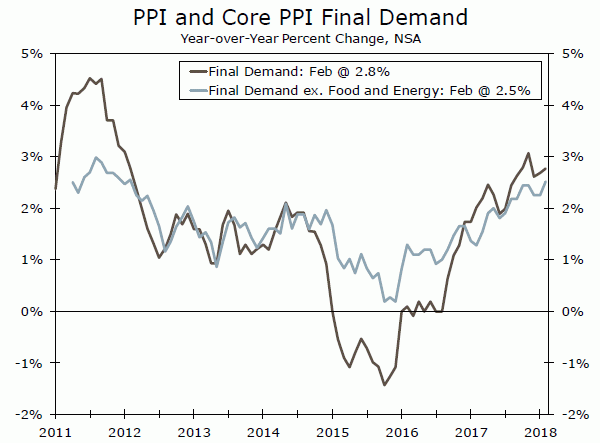 Consumer Price Index • Wednesday
Consumer Price Index • Wednesday
Consumer inflation has strengthened in recent months. On the heels of a strong January increase, the CPI rose 0.2 percent in February and is now up 2.2 percent over the year. Higher energy prices were less of a factor in February. The core CPI also increased 0.2 percent on the month and apparel prices continued to rise solidly, which helped offset declines in medical, commodities and education prices. Food and beverage, recreation and transportation prices were flat on the month while housing costs rose in line with recent readings.
Core CPI is running at 1.8 percent over the year, but that should rise closer to 2 percent in March as year-to-year comparisons will coincide with last year’s decline in wireless services. Inflation is firming more broadly as well, with ISM surveys continuing to show businesses paying higher prices. Inflation does not appear set to run out of control, however, giving the Fed space for gradual tightening.
Previous: 0.2% Wells Fargo: 0.1% Consensus: 0.0% (Month-Over-Month)
Import prices continued to climb in February, rising 0.4 percent to extend the streak of monthly gains to seven months. Import prices rose even though petroleum prices declined on the month, as nonfuel import prices rose 0.5 percent for the second straight month. Prices rose most in February for imported foods and beverages. Over the past year, prices for imported industrial supplies have seen the fastest growth along with petroleum.
Export prices continued to rise in February as the global demand picture continued to strengthen, and the dollar has generally been easing. The trade weighted dollar was largely flat in March.
Prior to the March announcement of tariffs on steel and aluminum, prices for both were already rising by double digits over the year. We expect only a marginal effect on final consumer prices from the steel and aluminum tariffs.
Previous: 0.4% Wells Fargo: 0.1% Consensus: 0.1% (Month-Over-Month)
Global Review
Foreign Central Banks Eye U.S. Developments
- Russian GDP growth missed expectations in Q4-2017 but still posted the fastest full-year growth since 2013.
- Purchasing Manager Indices in Europe and the United Kingdom suggest a slower pace of economic growth toward the end of Q1. Construction activity in the United Kingdom posted an especially soft reading in March.
- Both the Reserve Bank of India (RBI) and the Reserve Bank of Australia (RBA) kept their main policy rates unchanged this week. The RBI noted rising global trade tensions as a risk to the outlook, while the RBA cited rising short-term interest rates in Australia due to spillover effects from the United States.
Foreign Central Banks Eye U.S. Developments
Russia is typically one of the last major economies to report its GDP figures for the quarter, and data released this week showed Russian economic growth downshifting in Q4-2017. Household consumption continued to exhibit strength, but a notable deceleration in investment spending and inventories weighed on growth. Even with the miss, the annual GDP growth rate was 1.5 percent, which was the strongest outturn since 2013.
The Russian ruble nosedived in 2014-2016 due to the one-two punch of western sanctions following Russia’s annexation of Crimea and the collapse in oil prices. Since then, currency stabilization, a stronger global economic backdrop and more stable oil prices have caused inflation to recede and economic growth to return to positive territory. Consequently, the Central Bank of the Russian Federation has been in rate-cutting mode over the past three years, and most analysts look for it to ease policy further in coming quarters. We look for the economic recovery in Russia to remain intact this year as the decline in inflation boosts real income growth and easier monetary policy shores up interest ratesensitive spending.
To the west, Purchasing Manager Indices (PMIs) portrayed a slightly softer growth environment in the United Kingdom and the Eurozone. The Markit U.K. composite PMI fell to 52.5 in March, a two-point decline from February and the lowest reading since July 2016, when Brexit occurred. A particularly weak reading for the construction sector appeared to be the main culprit. The final March readings for the Eurozone PMIs also confirmed a 1.9 point drop in the composite index, which is now down 3.6 points from its recent high in January. Taken together, the surveys suggest that European economic growth remains firmly in expansion territory, but the pace of growth may be slowing from its recent peak.
Both the Reserve Bank of India and the Reserve Bank of Australia met this week, with neither central bank making a change to their main policy rates. The RBI lowered its inflation outlook relative to its February projections and noted the risks to the outlook from heightened trade tensions, saying that “even as global growth and trade have been strengthening, rising trade protectionism and financial market volatility could derail the ongoing global recovery.”
For the RBA, perhaps the most interesting development was that the policy statement noted that the increase in U.S. dollar shortterm interest rates has “flowed through to higher short-term interest rates in a few other countries, including Australia.” Thus, there appears to have been some de facto tightening in Australia despite the RBA remaining on hold. High debt levels and slow growth in household income remain a key challenge for the RBA, particularly in an environment of rising interest rates. Our baseline expectation is that the RBA will continue to remain on hold before eventually joining other global central banks in normalizing policy later this year with an eventual rate hike. The key is whether or not the elusive wage growth materializes.
Global Outlook
U.K. Industrial Production • Wednesday
Industrial production (IP) in the United Kingdom more or less flatlined in summer 2016 due, at least in part, to the uncertainty regarding the economic outlook that was imparted by the Brexit referendum. However, uncertainty has subsequently dissipated, at least somewhat, and IP has been trending higher. IP data for February, which will print on Wednesday, will give analysts more insights into the state of the British economy in the first quarter. The consensus forecast anticipates that IP rose 0.4 percent in February following its 1.3 percent rise in January.
Construction data for February will be released on Wednesday. Real construction spending fell 3.2 percent on a year-ago basis in January due in part to weakness in public expenditure on construction. A widely regarded think tank will release its estimate of Q1 GDP growth on Wednesday, which will help us calibrate our own estimate.
Previous: 1.3% Consensus: 0.4% (Month-Over-Month)
Eurozone Industrial Production • Thursday
The industrial sector in the Eurozone accelerated in 2017. Indeed, IP rose 2.9 percent last year, its strongest annual growth rate since 2011. But there are indications that growth in IP may have downshifted so far in 2018. Eurozone IP fell 1.0 percent in January relative to the previous month, and the manufacturing PMI has declined for three consecutive months after climbing to its highest level since 2000 in December. That said, the PMI remains well above the demarcation line separating expansion from contraction, indicating that the upward trend in IP probably remains in place.
IP in the euro area has been boosted in part by solid economic growth in the rest of the world, which has contributed to strong growth in Eurozone exports. Trade balance data for February are on the docket on Friday. These data and the IP data that will be released on Thursday will help analysts refine their GDP growth estimates for Q1.
Previous: -1.0% Consensus: 0.1% (Month-Over-Month)
Singapore will release its estimate of GDP growth in the first quarter on Friday. Although the Singaporean economy is tiny—it is only 2 percent the size of the U.S. economy—it is an important global bellwether. Historically, Singapore has been the first economy to release GDP data for the recently-completed quarter. Moreover, it is one of the most open economies in the world, and there is a high degree of correlation between Singaporean GDP growth and global economic growth. Consequently, Singaporean GDP data can shed some light on the current state of the global economy.
Global GDP growth strengthened in 2017 following its slowdown in 2015 and 2016, which contributed to the acceleration in the Singaporean economy last year. There are not many forecasters of Singaporean GDP growth, but the consensus looks for the year-overyear growth rate to have picked up further in Q1.
Previous: 3.6% Consensus: 4.4% (Year-Over-Year)
Point of View
Interest Rate Watch
Flatter Yield Curve: Actions and Expectations
As illustrated in the top graph, the spread of the 10-year over the 2-year has narrowed steadily over the past year. We do not expect that this is a signal of recession but rather the tension between actions and expectations in the capital markets. Our outlook is that the spread will narrow into the third quarter of this year to just 35 bps according to our March economic outlook.
FOMC Actions: Up
As illustrated in the middle graph the 2-year yield has risen steadily as the markets have been convinced that the FOMC path of the effective fed funds rate was moving up and likely to continue to move up in the year ahead.
Our outlook is for the FOMC to raise the federal funds rate again in June and likely twice more this year. The market expectation (according to Bloomberg) for a FOMC move to raise the federal funds rate in June is 78.5 percent. The FOMC has upgraded their economic expectations for both growth and inflation, and so we expect the FOMC for now to maintain their commitment to raise the federal funds rate this year and next. As a result, we have the 2-year at 2.70 percent at the end of the third quarter in our latest monthly.
Expectations: Down
Inflation expectations have steadily declined over the past six years as illustrated in the bottom graph. This pattern is counter to the traditional experience (note the pattern in the prior expansion, 2002-2006) of rising inflation and inflationary expectations. As a result, expectations for the 10-year rate have continually been above the actual turnout for the past four years.
So far the rebound in the CPI since 2014 has not yet fed into a rise of inflation expectations. Our expectation is that inflation will rise in the period ahead—we have the PCE deflator at 2.3 percent in the third quarter of this year and that would be consistent with an increase in the 10-year yield, but the increase in the 2-year yield will still generate a flatter yield curve—but no recession.
Credit Market Insights
Positive Today, Wary Tomorrow?
The New York Fed’s February Survey of Consumer Expectations showed that respondents remain positive about their current financial situation, yet are slightly wary of future credit conditions. Views on the current outlook are the highest since the survey started in 2013, with 40.2 percent of respondents stating that their financial situation is better off from a year ago. Sustained growth in personal income over the past few months and generally solid credit conditions were likely contributing factors to the jump in sentiment.
While consumers are largely satisfied with the status quo, survey respondents were less optimistic about future credit availability. Both the perceived change in credit availability compared to a year ago and expectations for year-ahead credit availability declined over the month.
These changes likely reflect perceived tightening in credit conditions over the coming quarters – the FOMC raised the fed funds rate 25 bps at its March meeting and we expect it to hike rates three more times this year. Higher interest rates will likely restrain the ramp up in consumer credit seen over the past few months as consumers begin to face higher debt servicing costs. However, the average perceived probability of missing a debt payment declined over the month to 11.6 percent at present, and is a silver lining for consumers amid higher debt servicing costs. Higher incomes have likely better equipped most consumers to handle higher debt payments.
Topic of the Week
How Costly Would a Full-Blown Trade War Be?
The United States and China have announced tariffs on each other’s goods in recent weeks, and they have threatened to impose even more. Assuming they take effect, the tariffs that China has announced thus far on American goods will focus on agricultural products, automobiles, aircraft and chemicals. Although exports of these industries to China are sizeable—exports of the agricultural and other primary products industry totaled nearly $20 billion in 2016—they represent a relatively small proportion of total industry output. For example, exports to China are equivalent to less than 5 percent of the output of the agricultural and other primary products industry. In our view, Chinese tariffs on these four broad industries would not a “big deal,” at least not from a macroeconomic perspective.
What happens if a full-blown trade war were to develop? Even in a worst-case scenario in which each country were to levy increased tariffs on all of the goods that the other country exports, the overall effect on the U.S. economy should be manageable. We estimate that the value added that is embodied in American exports to China accounts for only 0.5 percent of total value added in the U.S. economy. Looking at things the other way around, China’s exports to the United States generate about 2 percent of that country’s value added. It appears that China would have more to lose than the United States from an all-out trade war, should one develop.
But there could be other knock-on effects from a trade war that could potentially have deleterious consequences for the U.S. economy. Share prices likely would decline further if a full-blown trade war were to occur, and lower wealth could lead to slower growth in U.S. consumer spending. In addition, bond yields in the United States could rise if China was to unload some of its sizable holdings of U.S. Treasury securities.




